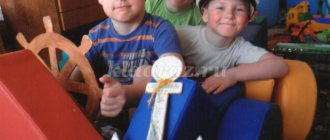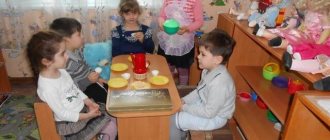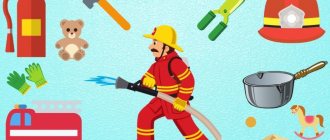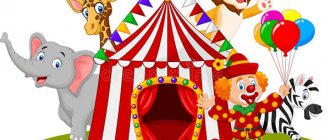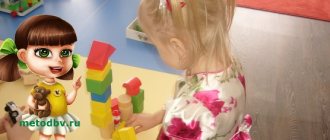Role-playing game “A trip to the theater”
Summary of the role-playing game in the senior group “A trip to the theater.”
GOAL: developing the ability to apply early knowledge about the surrounding life in the game.
TASKS:
Educational:
- Consolidating children's ideas about the theater, the theater troupe, and theater workers.
Educational:
- Developing the ability to act out a performance based on a familiar fairy tale.
- Development of the ability to expressively convey in speech the images of fairy tale heroes, to coordinate one’s actions with other “artists.”
- Improving the ability to create a game environment for a planned plot.
- Developing the ability to take on a role and act in accordance with it until the end of the game.
Educators:
- Forming positive relationships and a culture of behavior in public places, using polite words in speech.
PRELIMINARY WORK: conversations, going to the theater, making a poster.
GAME MATERIAL:
Screens, posters, tickets, costumes, elements of costumes, chairs, artificial flowers, bell, steering wheel, road sign “Bus stop” (2 pcs.), signs “Cash desk”, “Costume room”, “Getting room”, “Buffet”, toy dishes , models of products, furniture, bags, wallets, scenery for performances, theater booklets, illustrations.
GAME ROLES:
Artists, spectators, theater ticket cashier, make-up artist, costume designer, prop maker, theater buffet worker, bus driver, conductor.
PROGRESS OF THE GAME
Educator: “Guys, we talked a lot about the theater. I talked about the professions of people who are in the theater. We went with you and your parents to the theater. And today I want to invite you to go to the theater again.”
“How can we get there?”
Children: "On the bus"
Children use chairs to build a bus.
Teacher: “Before we get on the bus, do we need to choose who?”
Children: “Bus driver and conductor”
Educator: “How will we do this?”
Children: “A little counting rhyme will help us”
Children count, choose a driver and conductor, and take attributes for the game.
Children passengers occupy seats at bus stops.
On the bus, the children pay the conductor, receive tickets from him, and go to the Theater stop.
Educator: “Well, you and I have arrived at the theater. I wonder what performance is on at the theater today?”
The teacher draws the children's attention to the theater poster.
The children say that today there is a performance at the theater based on the fairy tale “The Fox and the Hare.”
Educator: “Guys, before we go into the theater, let’s assign roles.”
The teacher distributes the roles that the children will play and discusses them with the children.
Children go to their “workplaces”.
The actors, make-up artist, costume designer, prop maker go to prepare for the performance.
The props maker sets up the stage.
A buffet worker is arranging items in the buffet. Spectators go to the box office, buy tickets and wait for the performance to start in the foyer, looking at magazines and booklets. When the third bell rings, the audience sits down in the hall, and they are joined by a make-up artist, a costume designer, a cashier, and a buffet worker.
Children perform a performance. After watching the performance, the audience applauds the artists, shouts “Bravo!”, and gives flowers.
After the performance, the audience goes to the buffet, they are joined by artists and theater workers who have finished their work.
Educator: “Guys, the theater is closing soon, a bus is waiting for us to take us back to kindergarten.”
Children get on the bus and arrive at kindergarten.
Technological map of the role-playing game “Introduction to the profession of an actor”
Technological map of the role-playing game
Subject:
“Introducing preschoolers to the profession of
actor
” (based on a fairy tale)
Age category
: middle preschool age
Compiled by
: teacher Romacheva Yu.V.
SOD form
: role-playing game
Form of organization:
group
Facilities:
Visual:
chairs, tables, cash register, paper money, display case, candy, cakes, juice bags, flowers, baskets for
flowers, bell, masks (mouse, frog, hare, fox, wolf, bear), little house, trees, screen. Literary:
Russian folk tale “Teremok” (in a new way).
Target:
Introducing children to the profession of actor.
Tasks:
Form ideas about the theater. Arouse interest in theatrical activities, a desire to perform together
with a group of peers.
Educational:
Develop a culture of behavior in public places, use polite words in speech.
Educational:
Learn to convey expressively the images of fairy tale characters in speech. Improve your ability to create for
the planned plot and game setting. Teach children to assign roles with the help of an adult, select
attributes corresponding to the plot-role-playing game and the roles of children; learn to negotiate with each other in the process
games.
Educational:
Develop creative abilities through theatrical art. Develop children's expressiveness
intonation, facial expressions, movements.
Stages of activity
Contents of activity
Actions, activities of the teacher
Activities and actions of children that will lead to the achievement of planned results
Planned result
Motivation
Creating an environment in the group for the development of a role-playing game.
The teacher invites several children to visit the theater.
The children agree with the teacher. They talk about how they went to the puppet theater.
The children agreed to perform a role-playing game.
Introduction to the topic of activity
Choosing a familiar fairy tale.
Educator: Guys, I suggest you act out a familiar fairy tale yourself. What fairy tale do you know well?
Let's remember this fairy tale. The teacher pays attention to the character of the characters and asks the children to describe them.
Children choose the fairy tale “Teremok”, which they have learned in advance.
They rehearse their lines, conveying the character and habits of their hero.
The children repeated a familiar fairy tale.
Activity stage
Conversation about theaters.
Preparing for the performance.
The teacher helps the children develop the game.
Educator: There are different theaters: puppet, opera, drama, ballet theater. What kind of theater will you have?
In order for visitors to attend the performance, what needs to be done? Where can I find out about the show?
Have you prepared your tickets? Have you posted a poster?
Who in the theater will take care that the audience is comfortable, fun and even tasty?
Who is the most important person in the theater? Who brings joy to children?
Educator: Guys, now you will show the fairy tale “Teremok”. First you need to assign roles, prepare the scenery, and prepare for the performance yourself.
The bell rings.
Children: we will have a dramatic one - where the roles are played by the people themselves.
You need to purchase tickets in advance and make a poster.
Yes. Children “hang up” a poster announcing the performance. Spectators are invited to purchase tickets for the performance (the “ticket sale” plot).
Ticketer, cashier, barmaid, actors.
Artists, actors.
Children assign roles, set up screens for the towers and trees. The cashier opens the box office and sells tickets, spectators buy tickets.
Spectators come to the performance, the usher checks the tickets.
Children actors act out a fairy tale.
The children listed the types of theaters. We got acquainted with the profession of an actor. We prepared and sold tickets, rehearsed our roles. They showed the performance.
The final stage. conclusions
Discussion of what was seen.
Educator: Do you think your game turned out well?
Were you interested?
Did the actors perform well?
Did you find binoculars useful while watching?
Were the actors and the audience grateful? How did they express their gratitude?
I think you made a wonderful game.
Yes.
Very.
Children evaluate the actors' performance.
They came in handy.
The audience was grateful and there was applause.
The actors and spectators were satisfied with the organized game. At the end of the event, children play the game independently.
Role-playing game in the senior group "Theater"
Summary of the plot-role-playing game for the senior group of kindergarten
Description of the material: I bring to your attention a summary of the plot-role-playing game “Theater”. This game was played in the older group. The children really liked the game. Goals: * to consolidate children's ideas about cultural institutions, their social significance, children's knowledge about the theater, about the theater troupe, theater workers, to show the collective nature of work in the theater; *teach children to act in accordance with their assumed role, develop expressive speech; *form a friendly attitude between children, moral and ethical standards of behavior. Preliminary work: *invite parents to take their children to the theater; *conversation about our city’s theaters as cultural institutions; *examination of postcards with theaters in the city of Kemerovo; *conversation about the rules of behavior in the theater; *reading the fairy tale “Zhikharka” and telling the story by role; *making attributes for the game: a screen and its design, tickets, seat numbers, masks for actors, a poster, money, a cash register window, a “buffet” sign, sewing an apron and cap for the barmaid. Subject-game environment. Equipment: *requisites for the performance - screen, stove, spatula, bench, table, wooden spoons, wooden cups, cast iron, ladle, costume elements;
*details for the buffet - sign “buffet”, cash register, money, products (cakes, chocolates, juices, candies), apron, cap, doll dishes (cups, teapots, saucers, tray), flowers; *details for the cash register - cash register window, calculator, money; *details for the controller - chairs, numbers. Progress of the game
Educator: Children, what unusual did you see today when you entered the group? Children: Poster! Educator: Who can read what is written on it? (Children read) Educator: What do you think the poster is for? Children: So that we know that there will be a performance and come to it. Educator: What is the name of the institution where the performances are held? Children: Theaters. Educator: What clothes do we wear to the theater and how should we behave there? Children: We go to the theater in smart clothes, beautifully combed, talk in a low voice, politely, don’t run, throw garbage in trash cans, etc. Educator: That’s right. The theater is a cultural institution and you need to behave culturally there. Do you want to play in the theater? Children: We want! Educator: In order to start playing, what should we do? Children: Distribute roles. Educator: Let's remember who works in the theater? Children: Controller. Educator: What duties does the controller perform? Children: Places chairs in rows, hangs numbers on them, checks tickets from spectators, helps them find their place. Educator: Who will be the controller? Please go get your workspace ready. Children: Cashier. Educator: What are the responsibilities of a cashier? Children: The cashier sells tickets. Educator: Who will be the cashier? Please go get your workspace ready. Who else works in the theater? Children: Barmaid. She puts the goods on the counter and sells them during intermission. Educator: Who will take on the role of barmaid? Please get to work. Children: Stage workers also work there. They arrange the details. (The teacher chooses two boys) Educator: Without whom there can be no theater and why? Children: Without actors, they are showing a performance. (Artists and pre-prepared children go behind the screen and put on masks.) Educator: And you and I will be spectators. What will we do in the game? Children: Buy tickets, take your seats, when there is intermission, let's go to the buffet to buy food, clap your hands, give flowers to the artists. Educator: Let's get ourselves in order, fix our hair and go to the theater. What will we go on? Children: By car, by bus. (The teacher invites those children who will take the bus to go to the stop. The driver and conductor take their attributes, passengers take imaginary seats, the bus moves. The conductor announces: “The stop is a theater,” passengers get off the bus, cross the road at the pedestrian crossing, enter theater.) Children play according to assigned roles. The teacher approaches the children and looks at how they cope with their responsibilities and helps if necessary. The first bell rings, the second, the third. The audience takes their seats. The performance begins. The teacher reads the words of the author, the artists perform their roles. The first act is over. An intermission is announced. Spectators go to the buffet to buy food. Stagehands rearrange props. The controller checks the numbers on the chairs. (The teacher asks all the children to come up to her) Teacher: Children, do you like to play the game? Children: Yes! Educator: How do you think the cashier copes with his duties? Was she polite to you? What polite words did she say to you? (The teacher talks with the children about each role. The children evaluate each role played.) Educator: Children, do you want to continue playing in the theater? Children: Yes! Educator: Then the game continues, taking into account all the wishes. The first bell rings, the second, the third. Spectators take their seats in the hall. The second act begins. The teacher reads the words of the author. The actors are performing a performance. The counter in the buffet is being updated, candy boxes are being put on display, and flowers are going on sale. The second act is over. An intermission is announced. Spectators go to the buffet, buy candy, flowers, and fix their hair. Stage workers rearrange props for the performance. The first bell rings, the second, the third. Spectators with flowers take their places. The third act begins. At the end of the performance, the audience clap their hands, shout: “Bravo!”, throw flowers onto the stage or present them to the artists. The artists bow and go backstage with flowers. (The teacher asks all the children to come up to her) Teacher: Do you think our game was a success? Children: Yes! Educator: What did you like most? (The children say what they liked most about the game. The teacher summarizes the children’s statements and thanks everyone playing.)
We recommend watching:
Plot-role-playing game for older preschoolers Fashion Atelier Plot-role-playing game in the senior group of a kindergarten Summary of the plot-role-playing game “Cafe” for the senior group in a kindergarten Project. Development of role-playing games in the middle group of kindergarten
Similar articles:
Role-playing game in early preschool age
Games, songs, exercises for younger preschoolers “Igralochka”
Summary of the role-playing game “We are going to the theater” for secondary children. groups
Municipal budgetary preschool educational institution
“Combined kindergarten No. 17 “Rucheek”
Summary of a role-playing game with children of middle preschool age
"We're going to the theater"
Educator: Kovalskikh M.V.
Mezhdurechensk 2019
Target:
introducing children to the art of theater.
Tasks:
1.Give an idea of theatrical professions (cashier, controller, actor) 2.Teach children to dramatize a familiar work, coordinate the words and actions of the characters. 3. Foster a culture of behavior in public places, interest and desire to play
Activating the dictionary:
poster, performance, polite words, theater, actors, cashier, controller, spectators, applause.
Materials:
screen, tickets, table, chairs, animal masks, cash register, bell;
Preliminary work:
Telling the fairy tale “Whose mother is better” by O. Bukhartsev, looking at the illustrations; work on expressiveness of speech; conversation about theatrical professions.
Progress of the game.
Before the game starts, prepare everything you need. Place a table for the ticket office and a screen, tickets, a model of a bus, a steering wheel, attributes for the actors, a screen with a curtain. Masks for performers of animal roles, chairs for spectators, a model with photographs of the streets of our city, for each child, tokens on a string for: driver, controller, cashier, artists, spectators, round, but different in color.
Give the children badges.
Educator
: Stand up, children,
Stand in a circle.
As soon as the children stand in a circle, there is a knock on the door. The postman brought a letter. The letter contains a poster.
Educator
: Guys, what do you think this poster is?
Children:
This is a poster for the play.
Educator
: What can you learn from the poster?
Children:
Where and what kind of performance will be shown.
View the poster
Educator
: Guys, they invite us to the theater, shall we go?
Children:
Yes
Educator
: What will we go on?
Children:
By bus
Educator
: Where is our bus?
Draw the children's attention to the model of the bus.
Educator
: We need a driver. Who has a purple token on a string? At Sasha's. Sasha, get ready. Let's get on the bus
Children get on the bus
Educator
: Let's review the rules of behavior on the bus
Children:
Sit, don't run, don't scream.
Place a layout with photos of city streets on the table. I draw the children’s attention to the photographs and tell them which street we are passing.
Educator
: Here we are. Where in the theater do the audience watch the performance?
Children:
in the auditorium.
Educator
: What should you buy at the theater to get into the auditorium.
Children:
You need to buy a ticket.
Educator
: Where do you buy tickets?
Children:
Tickets are purchased at the theater box office.
I draw the children's attention to the cash register.
Educator
: Who works at the cash register.
Children:
Cashier.
Educator
: Who has a yellow token on a string? Alina will be our cashier. Go to the cashier and get ready.
Role-playing game for children “Theater”
“Theater is not fashion – it is forever!”
Role-playing game "Theater" in the preparatory group
Goal: To develop the ability to apply previously acquired knowledge about the surrounding life in the game. Strengthen children's understanding of the theater. Form positive relationships and a culture of behavior in public places. To develop children’s ability to perform a performance based on the familiar fairy tale “Turnip”, expressively convey in speech the images of the fairy tale’s heroes, and coordinate their actions with other “artists”. Improve the ability to create a game environment for a planned plot.
Tasks:
Educational field “Social and communicative development”:
- Development of children's play activities
- Establish rules of behavior in public places
- Develop the ability to listen to comrades, thank the “artists” with applause.
Educational field “Speech development”:
- Children's practical knowledge of speech norms
- Enrichment of vocabulary (poster, foyer, auditorium, scenery, stage, costume designer, puppeteer, director).
- Introduction to verbal art
Educational field “Artistic and aesthetic development”:
- Development of musical and artistic activities
- Production of tickets, posters
- Organization of the exhibition “Favorite Fairy Tale Hero”
PRELIMINARY WORK: conversations, visiting the theater, observations, reading a fairy tale, puppet show, joint production of attributes for the game.
GAME ROLES: cashier, buffet worker, controller, artists, spectators.
GAME MATERIAL: box office, theater tickets, poster, screen, large signs “Theatre”, “Auditory Hall”, “BUFFET”, “Flower Shop”, flowers in vases and baskets, display case in the cupboard, toy dishes, food models, furniture, bags, money, chairs, where the row and place are marked.
Progress of the game.
Educator: Children, today they handed me a mysterious envelope. (I read the address.) Let's see what's in this envelope. And in this envelope is a poster for the play.
I draw the children's attention to the poster.
- Look, they sent us a poster from the theater. After reading it, we will find out what kind of performance will take place in the theater, when and at what time.
I suggest the children read the poster.
— Guys, the play “Turnip” will take place today at 10 o’clock.
— Tell me, please, what is theater? (children's answers)
— What types of theaters do you know? (children's answers)
Educator: Today there are a great many varieties of theater to suit every taste. Drama theater is a classic one. Ballet, Opera, the works of which are staged in a small room for a not very large circle of people, are called chamber theater, Author's theater (also called non-traditional, experimental), animal theater (for example, Durovs, Kuklachev), shadow theater, for children - theater for young spectators , puppet theater, theater of miniatures, when the production itself is short in duration.
— We also have theaters in the city of Bryansk.
— What theaters are there in our city? (Children's answers)
Bryansk Regional Drama Theater named after. A.K. Tolstoy, Bryansk Regional Theater for Young Spectators, Bryansk Regional Puppet Theater, Children's Musical Theater "Orpheus"
- Who works in the theater? (children's answers)
— where do the artists perform? (children's answers) and if the theater is a puppet theater, who will be the actor then? (children's answers) But the dolls themselves cannot move, who controls them? (children's answers). Who directs the production of the play and distributes the roles? (children's answers)
- before we go to the theater, let's remember the rules of behavior in the theater.
1. You must come to the performance on time, you cannot be late
2. don’t make noise, don’t knock, don’t talk,
3. do not shout, do not bring food with you and eat during the performance, do not damage the furniture.
After the end of the performance, you should thank the artists for their performance with applause or give them flowers.
“It’s time for us to go to the theater immediately so as not to be late for the performance.”
Song "It's fun to walk together..."
Educator: Here we are. Come on in. Children, what is needed to get to the theater for a performance? (children's answers). Of course, get in line and buy a ticket at the box office. Let's choose who will be our cashier and controller who will check the tickets? (You can choose with a little count).
Go to the cashier.
Children buy tickets.
After purchasing a ticket, children enter the theater foyer. The controller checks the tickets.
- Children, we went into the foyer with you. Who can tell me what a foyer is? (children's answers)
Wardrobe. Children, please tell me what a wardrobe is for and what it is? (children's answers). Who works there? (children's answers).
- What do you think we can do with our free time before the performance starts? (children's answers).
I assign one of the children to the role of a buffet worker.
— How can you thank the artists after watching the performance? (children's answers).
Right. We have a flower kiosk.
The first bell rings. After the first bell, children enter the auditorium and take a seat according to the image on the ticket (geometric shapes of various colors and numbers)
Actors - children go behind the screen to show a fairy tale
The second bell rings. The audience applauds. After the third bell, the show begins.
After the performance, the audience applauds, the artists come out to bow.
- Guys, where were we today?
Summarizing:
Which theater?
What is the name of the fairy tale we watched?
What did you like most?
And I really liked the way you played, you handled your roles well, you were polite, behaved correctly in public places, and tried to expressively convey the images of the fairy tale characters in your speech. Next time you play this game, you will switch roles.
